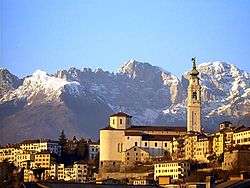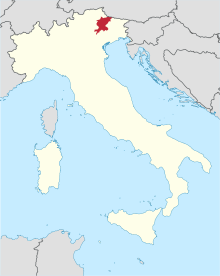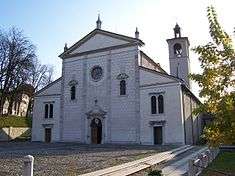Roman Catholic Diocese of Belluno-Feltre
| Diocese of Belluno-Feltre Dioecesis Bellunensis-Feltrensis | |
|---|---|
 | |
| Location | |
| Country | Italy |
| Ecclesiastical province | Venice |
| Statistics | |
| Area | 3,263 km2 (1,260 sq mi) |
| Population - Total - Catholics |
(as of 2012) 187,385 187,300 (100.0%) |
| Parishes | 158 |
| Information | |
| Denomination | Catholic Church |
| Rite | Roman Rite |
| Established | 2nd Century |
| Cathedral | Basilica Cattedrale di S. Martino (Belluno) |
| Co-cathedral | Concattedrale di S. Pietro Apostolo (Feltre) |
| Secular priests | 200 |
| Current leadership | |
| Pope | Francis |
| Bishop | Renato Marangoni |
| Map | |
 | |
| Website | |
| www2.diocesi.it/bellunofeltre | |

The Diocese of Belluno-Feltre (Latin: Dioecesis Bellunensis-Feltrensis) is a Roman Catholic ecclesiastical territory in the Veneto, northern Italy, created in 1986. The historic Diocese of Belluno and Diocese of Feltre were united under the name diocese of Belluno e Feltre in 1818. The diocese is a suffragan of the Archdiocese of Venice.[1][2]
History
At the end of the 10th century Belluno was affected by the political disturbances then agitating the Venetian provinces. Bishop Joannes II (959) obtained from Emperor Otto I for himself and his successors the title of count and temporal sovereignty over the city and the surrounding territory. He also fortified the city.
Christianity is said to have been first preached there by St. Hermagoras, a disciple of St. Mark and first Bishop of Aquileia, and next by Prosdocimus, first Bishop of Padua. Ferdinando Ughelli places the first bishop, Theodorus, in the reign of Emperor Commodus and the second, St. Salvator, as succeeding under Pertinax. About 300 another Theodorus is thought to have brought from Egypt the remains of St. Giovata, patron of the city.
The first bishop known to history is a certain Laurentius. In 587, he attended the schismatic assembly convened by Severus, Patriarch of Aquileia, in connection with the schism of the Three Chapters.
The twelfth century was a stormy period for Belluno, in both civil and ecclesiastical respects. In 1197 Bishop Gerardo de Taccoli was murdered by the inhabitants of Treviso, after which Pope Innocent III united the Diocese of Belluno with that of Feltre.
In 1462, at the request of the Venetian Republic, the two dioceses were separated. The first Bishop of Belluno was then Ludovico Donato. Bishops Pietro Barozzi, Mose Buffarello, and Bernardo Rossi (1499) rebuilt the cathedral. Luigi Lollin (1595) promoted the love of learning among the clergy and left bequests to provide for a number of priests at the University of Padua. Giulio Berlendis (1655) completed the work of enforcing the Tridentine reforms, and Gianfrancesco Bembo, a member of the Somaschi (1695), was zealous in the cause of popular education. In 1818 the diocese was reunited with that of Feltre.[3]
Ordinaries
Diocese of Belluno
Erected: 2nd Century
Latin Name: Bellunensis
Metropolitan: Patriarchate of Venice
Diocese of Belluno e Feltre
United: 1197 with Diocese of Feltre
Latin Name: Bellunensis et Feltrensis
Metropolitan: Patriarchate of Venice
- Enrico Scarampi (9 Apr 1404 - 29 Sep 1440 Died)
- Francesco Legnamine (de Padua) (18 Apr 1460 - 11 Jan 1462 Died)
Diocese of Belluno
Split: 1462 to reestablish Roman Catholic Diocese of Feltre
Latin Name: Bellunensis
Metropolitan: Patriarchate of Venice
- Ludovico Donato (Donà) (2 Apr 1462 - 9 Jan 1465 Appointed, Bishop of Bergamo)
- Mosè Buffarello (5 Jan 1465 - 1471 Died)
- Pietro Barozzi (4 Sep 1471 - 14 Mar 1487 Appointed, Bishop of Padova)
- Bernardo de' Rossi ( 1488 - 16 Aug 1499 Appointed, Bishop of Treviso)
- Bartolomeo Trevisan (26 Aug 1499 - 4 Sep 1509 Died)
- Galeso Nichesola (19 Sep 1509 - 2 Aug 1527 Died)
- Giovanni Battista Casale (18 Sep 1527 - Sep 1536 Died)
- Gasparo Contarini (23 Oct 1536 - 24 Aug 1542 Died)
- Giulio Contarini (11 Sep 1542 - 9 Aug 1575 Died)
- Giovanni Battista Valier (9 Aug 1575 Succeeded - 1596 Resigned)
- Luigi Lollino (29 Jul 1596 - 28 Mar 1625 Died)
- Panfilo Persico (1625 - 14 Dec 1625 Died)
- Giovanni Delfino (bishop of Belluno) (9 Feb 1626 - 1634 Resigned)[4]
- Giovanni Tommaso Malloni (Mallono), C.R.S. (26 Jun 1634 - 7 Feb 1649 Died)
- Giulio Berlendi (6 Oct 1653 - 21 Oct 1693 Died)
- Gianfrancesco Bembo (bishop), C.R.S. (1 Mar 1694 - 21 Jul 1720 Died)
- Valerio Rota (16 Sep 1720 - 8 Sep 1730 Died)
- Gaetano Zuanelli (11 Dec 1730 - 25 Jan 1736 Died)
- Domenico Nicola Condulmer (27 Feb 1736 - 14 Mar 1747 Died)
- Giacomo Costa, C.R. (29 May 1747 - 19 Aug 1755 Died)
- Giovanni Battista Sandi (24 May 1756 - 12 Aug 1785 Died)
- Sebastiano Alcaini, C.R.S. (26 Sep 1785 - 4 Mar 1803 Died)
Diocese of Belluno e Feltre
United: 1 May 1818 with Roman Catholic Diocese of Feltre
Latin Name: Bellunensis et Feltrensis
Metropolitan: Patriarchate of Venice
- Luigi Zuppani (23 Aug 1819 Confirmed - 26 Nov 1841 Died)
- Antonio Gava (22 Jun 1843 Confirmed - 3 Nov 1852 Resigned)
- Vincent Scarpa (7 Apr 1854 Confirmed - 5 May 1854 Died)
- Giovanni Renier (17 Dec 1855 Confirmed - 12 Apr 1871 Died)
- Salvatore Giovanni Battista Bolognesi, C.O. (27 Oct 1871 - 29 Jan 1899 Died)
- Francesco Cherubin (19 Jun 1899 - 3 Jul 1910 Died)
- Giuseppe Foschiani (3 Jul 1910 Succeeded - 5 Oct 1913 Died)
- Giosuè Cattarossi (21 Nov 1913 - 3 Mar 1944 Died)
- Girolamo Bartolomeo Bortignon, O.F.M. Cap. (9 Sep 1945 - 1 Apr 1949 Appointed, Bishop of Padova)
- Gioacchino Muccin (19 May 1949 - 1 Sep 1975 Retired)
- Maffeo Giovanni Ducoli (7 Oct 1975 - 2 Feb 1996 Retired)
- Pietro Brollo (2 Jan 1996 - 28 Oct 2000 Appointed, Archbishop of Udine)
- Vincenzo Savio, S.D.B. (9 Dec 2000 - 31 Mar 2004 Died)
- Giuseppe Andrich (29 May 2004 - 10 Feb 2016 Retired)
- Renato Marangoni (10 Feb 2016 - )
Notes
- ↑ "Diocese of Belluno-Feltre" Catholic-Hierarchy.org. David M. Cheney. Retrieved March 20, 2016
- ↑ "Diocese of Belluno–Feltre" GCatholic.org. Gabriel Chow. Retrieved March 20. 2016
- ↑ Catholic Encyclopedia article
- ↑ "Bishop Giovanni Delfino" Catholic-Hierarchy.org. David M. Cheney. Retrieved March 21, 2016
![]() This article incorporates text from a publication now in the public domain: Herbermann, Charles, ed. (1913). "article name needed". Catholic Encyclopedia. New York: Robert Appleton.
This article incorporates text from a publication now in the public domain: Herbermann, Charles, ed. (1913). "article name needed". Catholic Encyclopedia. New York: Robert Appleton.
Coordinates: 46°08′00″N 12°13′00″E / 46.1333°N 12.2167°E